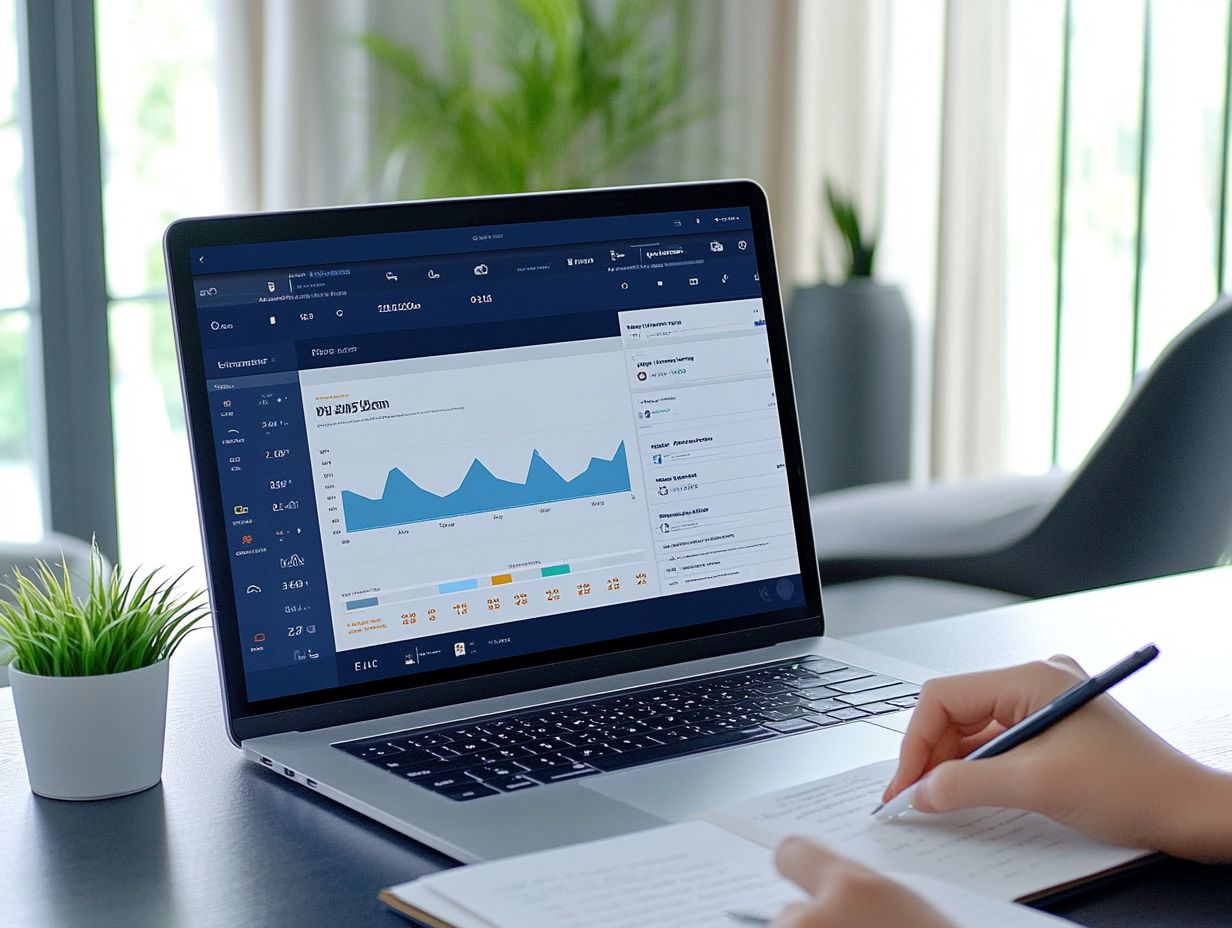5 Tools to Monitor Cloud Migration Progress
Cloud migration stands as a pivotal strategy for enhancing efficiency, scalability, and flexibility within your business.
However, the journey to the cloud is not without its challenges. To make this process easier, it’s essential to utilize the right tools.
This article delves into five crucial categories of cloud migration tools assessment, planning, execution, monitoring, and cost management. You’ll discover their importance, key features to consider, and how they can streamline your migration, ultimately ensuring a successful transition to the cloud.
Let’s dive in and see how these tools can transform your migration experience!
Contents
- Key Takeaways:
- 1. Cloud Migration Assessment Tools
- 2. Cloud Migration Planning Tools
- 3. Cloud Migration Execution Tools
- 4. Cloud Migration Monitoring Tools
- 5. Cloud Migration Cost Management Tools
- What Is Cloud Migration and Why Is It Important?
- What Are the Key Factors to Consider When Choosing Cloud Migration Tools?
- How Can These Tools Help with the Cloud Migration Process?
- What Are the Top Features to Look for in Cloud Migration Tools?
- How Can These Tools Improve the Efficiency and Accuracy of Cloud Migration?
- What Are the Potential Challenges of Using Cloud Migration Tools?
- Frequently Asked Questions
- Curious about the top 5 tools for tracking cloud migration progress?
- How does CloudWatch help in monitoring cloud migration progress?
- Can Azure Monitor be used for monitoring non-Azure resources?
- What are the benefits of using Google Cloud Monitoring for cloud migration monitoring?
- How does Dynatrace contribute to a smooth cloud migration process?
- Can AppDynamics integrate with other monitoring tools for cloud migration progress?
Key Takeaways:

- Assess your needs: Evaluate your current setup to choose the right migration approach.
- Plan ahead: Create a detailed migration strategy that covers security and cost.
- Track progress: Use monitoring tools for real-time updates to address issues quickly.
1. Cloud Migration Assessment Tools
Cloud migration assessment tools are essential for evaluating your organization s infrastructure readiness. They ensure data integrity and compliance standards are upheld while identifying potential migration challenges and opportunities for cost efficiency.
These tools offer in-depth insights into your existing environment by analyzing workload performance, resource utilization, and application dependencies. Platforms like AWS Migration Hub and Microsoft Azure Migrate provide customized solutions that cater to various cloud environments, allowing you to transition your applications seamlessly while considering key performance indicators for cloud migration.
These assessment tools excel at pinpointing data sources. They help you understand precisely where your critical data resides and how it can be migrated effectively. By leveraging advanced analytics, you can gain predictive insights that forecast potential bottlenecks and evaluate the total cost of ownership, giving you the power to make informed decisions throughout the migration process.
2. Cloud Migration Planning Tools
Cloud migration planning tools are essential for crafting a thorough migration strategy that aligns seamlessly with your business objectives. They ensure effective data management, allowing smooth integration across various cloud platforms while offering a user-friendly interface for your teams.
Developing a clear migration plan is essential for any organization aiming to transition to the cloud. This process begins with identifying specific objectives that will steer your migration, whether it s improving scalability or enhancing security.
A comprehensive assessment of your current infrastructure is equally important. This provides insights into available resources and what may require updates or replacements. Careful mapping out of the transition helps ensure that each stage is meticulously planned, minimizing the risk of disruptions.
Incorporating training sessions is also crucial to help users acclimate to new tools and platforms. This fosters a smoother transition overall. Implementing effective data governance practices during this planning phase is vital for maintaining compliance and safeguarding sensitive information, ensuring that your migration addresses both technical requirements and regulatory standards.
3. Cloud Migration Execution Tools
Cloud migration execution tools are your allies in the data transfer process. They allow you to seamlessly move your assets from on-premises setups to leading cloud platforms like AWS, Azure, and Google Cloud.
These tools ensure operational continuity and provide real-time access to your data, all while using tools that monitor performance during the move. They efficiently transfer large datasets and feature real-time data replication, which means copying data in real-time to reduce downtime.
Take AWS Migration Hub, for example; it enables you to track your migration progress across various AWS and partner solutions. It offers insights through detailed dashboards that highlight performance metrics.
On the other hand, Azure Migrate simplifies the application assessment process and delivers tailored recommendations for optimizing your cloud architecture. Meanwhile, Google Cloud’s data transfer services prioritize swift and secure transfer methods, employing robust security measures to safeguard data integrity during transit.
By harnessing these unique capabilities, you can ensure a smooth transition to the cloud, protecting your valuable assets while maximizing the benefits of your new environment.
4. Cloud Migration Monitoring Tools

Cloud migration monitoring tools are essential for ensuring that your migration process maintains data integrity and meets compliance standards. For instance, using the top 5 migration tools for cloud solutions can provide real-time insights and performance monitoring, enabling you to implement effective disaster recovery strategies.
These tools allow you to closely observe the flow of data, ensuring that no critical information is lost or distorted as you transition between environments. For instance, solutions like Datadog and New Relic offer exceptional data observability features.
These features allow your teams to monitor applications and infrastructure from a unified platform. By leveraging such tools, you can swiftly detect anomalies and address potential compliance violations, ensuring that data privacy regulations like GDPR and HIPAA are rigorously followed.
These monitoring systems facilitate a smoother migration experience, ultimately contributing to the project’s overall success and ensuring the reliable operation of your applications in the cloud, especially when following the 7 steps to a successful cloud migration.
5. Cloud Migration Cost Management Tools
Cloud migration cost management tools are vital for your organization if you’re aiming to optimize cloud spending. These tools provide valuable insights into pricing structures, offer flexible pricing options, and assist with migration, ensuring cost efficiency and data security throughout the process.
They play a crucial role in uncovering cost-saving opportunities by analyzing patterns in your current expenses and pinpointing areas of inefficiency. Understanding the nuanced pricing structures from various cloud providers such as AWS, Azure, and Google Cloud is essential for accurately forecasting future costs and steering clear of any surprise bills.
By harnessing these insights, you can make well-informed decisions, effectively track your expenditures during the transition, and adapt your strategies to maximize your investments in the cloud ecosystem.
What Is Cloud Migration and Why Is It Important?
Cloud migration is all about transferring your data, applications, and various business elements from on-premises servers or outdated systems to cloud platforms. This process is becoming increasingly vital for enhancing your business agility, improving cloud infrastructure, and ensuring robust security measures in today s digital landscape.
This multifaceted approach includes several dimensions, such as data migration, where you move your databases and information storage to the cloud, and application migration, which involves relocating your software applications to cloud-based environments.
By embracing cloud migration, you can significantly elevate your company s capabilities. You’ll enjoy unmatched scalability, allowing you to easily adjust resources according to fluctuating demands. It also provides cost efficiency by reducing the need for expensive hardware and ongoing maintenance.
As market conditions shift rapidly, cloud migration gives you the power to remain competitive and responsive. Don t wait too long to migrate; every moment counts in maximizing your cloud potential!
What Are the Key Factors to Consider When Choosing Cloud Migration Tools?
When selecting cloud migration tools, carefully consider key factors such as data accessibility, user feedback, customer support levels, and compatibility with various cloud service providers. This will ensure a smooth migration experience.
Evaluating tools for ease of use is crucial. A user-friendly interface helps your staff adapt quickly, speeding up the transition to new systems.
The integration capabilities of your chosen tools with existing software are vital for maintaining business continuity and streamlining workflows. Don’t overlook security features; safeguarding sensitive data during migration is essential.
Positive customer testimonials and detailed case studies showcase successful migrations, providing the reassurance you need as a decision-maker in search of reliable solutions.
How Can These Tools Help with the Cloud Migration Process?

Cloud migration tools make data transfer a breeze, offering features like data validation, transferring data without delays, and detailed analytics. These capabilities are essential for evaluating cloud migration success and help you mitigate risks while ensuring effective recovery plans for unexpected issues during migration.
Many tools come equipped with automated workflows and user-friendly dashboards, simplifying the monitoring and adjustments of your migration processes, as highlighted in cloud migration tools: a comprehensive guide.
Consider solutions like AWS Database Migration Service, which excels in transferring data without delays, enabling seamless transitions with minimal downtime. Similarly, Azure Migrate focuses on solid data validation features, ensuring data integrity remains intact throughout the entire move.
By leveraging these advanced functionalities, you achieve a more efficient migration while enhancing reliability and security, significantly reducing potential disruptions.
What Are the Top Features to Look for in Cloud Migration Tools?
When considering cloud migration tools, focus on key features:
- User-friendly interface
- Robust security measures
- Comprehensive performance monitoring
- Strict adherence to compliance standards
These elements are essential for ensuring both ease of use and data integrity throughout the migration process.
A user-friendly interface allows your teams to adapt quickly, resulting in a smoother transition. Tools like CloudEndure are excellent for simplifying the management of complex migrations.
Robust security measures are crucial; using tools like AWS Security Hub can protect sensitive data during transfer. Performance monitoring tools like New Relic or Datadog track real-time system performance and identify potential bottlenecks. Compliance ensures regulatory standards are met, minimizing the risk of costly legal issues.
Solutions like Qualys offer automated compliance checks, which are vital for maintaining operational integrity during and after the migration.
How Can These Tools Improve the Efficiency and Accuracy of Cloud Migration?
Cloud migration tools greatly enhance the efficiency and accuracy of your migration by using advanced analytics and automation. They streamline data transfer, minimizing human errors and ensuring accurate moves to the new cloud environment.
By automating tasks like data mapping, validation, and real-time monitoring, these tools significantly reduce the manual effort typically required for large data sets.
For example, platforms like AWS Migration Hub and Google Cloud Migrate use sophisticated algorithms to quickly identify and correct inconsistencies, reducing errors that often arise from human intervention.
The advanced analytics in these solutions not only speed up migration but also enhance overall accuracy, allowing you to confidently transition to your new cloud infrastructure.
What Are the Potential Challenges of Using Cloud Migration Tools?
Despite their advantages, using cloud migration tools can come with challenges that need your attention. You may face data security concerns and the need to keep operations running during the migration.
User feedback may vary regarding the effectiveness of these tools, depending on your organization s specific needs. Integration challenges often arise when you try to align new cloud solutions with existing systems.
This misalignment can lead to downtime, which ultimately affects productivity and user satisfaction. Planning is key to overcoming these challenges!
Conducting thorough assessments of your specific requirements and gathering user feedback will help you identify the most suitable tools for your organization.
By proactively addressing these challenges and thoughtfully selecting solutions that fit your unique environment, you can minimize disruptions and facilitate a smoother transition to cloud technologies. Don t wait! Start planning today to ensure a smooth transition!
Frequently Asked Questions

Curious about the top 5 tools for tracking cloud migration progress?
The top 5 tools are CloudWatch, Azure Monitor, Google Cloud Monitoring, Dynatrace, and AppDynamics.
How does CloudWatch help in monitoring cloud migration progress?
CloudWatch is a monitoring tool from Amazon Web Services (AWS) that provides real-time insights into resource utilization and performance metrics. It helps track cloud migration progress by delivering detailed insights into the performance and health of migrated resources.
Can Azure Monitor be used for monitoring non-Azure resources?
Yes, Azure Monitor can monitor non-Azure resources using the Log Analytics feature. This creates a centralized monitoring platform for both Azure and non-Azure resources, offering a holistic view of migration progress.
What are the benefits of using Google Cloud Monitoring for cloud migration monitoring?
Google Cloud Monitoring provides a variety of capabilities, including real-time metrics, dashboards, alerts, and logs. It also features advanced options like anomaly detection and root cause analysis, making it a comprehensive tool for monitoring cloud migration progress.
How does Dynatrace contribute to a smooth cloud migration process?
Dynatrace is an application performance monitoring tool that helps identify performance issues during cloud migration. It offers insights into application dependencies, infrastructure performance, and user experience, ensuring a successful migration.
Can AppDynamics integrate with other monitoring tools for cloud migration progress?
Yes, AppDynamics can integrate with other monitoring tools like CloudWatch, Azure Monitor, and Google Cloud Monitoring. This integration provides a more comprehensive view of migration progress and helps detect issues or bottlenecks across different cloud platforms.






